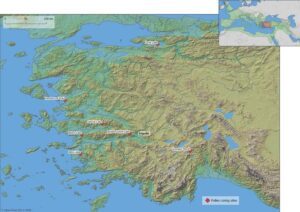
American Association for the Advancement of Science (AAAS)—By poring through ancient coin records and pollen data, researchers have reconstructed how the Roman conquest of Anatolia (modern-day Turkey) led to profound economic and environmental changes that mirror those seen with modern civilization. The new study sheds light on a unique period of globalization almost two millennia in the past, and could guide efforts to study the stability and future of our own increasingly interconnected world. As the Roman Republic conquered the Mediterranean world, its rulers began incorporating territories far away from Italy. One of its largest prizes was western Anatolia, which was home to various Greek city-states that were subsumed into the republic in the late 2nd century BCE. Acting as a bridge between East and West, Anatolia developed rapidly after the Roman conquest. It would become one of the empire’s most important provinces and would remain a core territory for the Eastern Romans even as the Western Empire fragmented in the 5th century CE. Mustafa Doğan and colleagues point out that the development of Roman Anatolia offers an excellent model for the Great Acceleration, or the profound socioeconomic changes linked to modern civilization and its impact on the planet. They examined a database of ancient coins and applied social analysis, finding that Anatolian cities such as Tripolis became increasingly interconnected with regional trade networks and imperial infrastructure. The team also studied fossilized pollen from Buldan Yayla Lake in western Turkey, located close to Tripolis. This revealed an exponential surge in olive pollen and a drop in other tree pollens after the Roman conquest, suggesting that native forests were quickly replaced by large-scale olive tree plantations within a century. The team linked other shifts in olive and cereal pollens to later economic transformations and events such as the growth of Constantinople in the 4th century CE. Ultimately, pollen data indicated that both crops disappeared in the 7th century CE and were replaced by regrowing forests, which coincided with the devastating war between the Eastern Empire and Sassanid Persia and the gradual disintegration of the Roman world.
______________________________

Western Anatolia with the key paleoenvironmental archives. The inlet shows Western Anatolia’s location within the Roman Empire. The city of Tripolis is marked due to its proximity to the high-resolution pollen profile of Buldan Yayla Lake presented in this article. Doğan et al., Sci. Adv. 11, eadt7107
______________________________
Article Source: AAAS news release
*ENVIRONMENTAL CHANGE AND GLOBALIZATION DYNAMICS IN ROMAN ANATOLIA: STABILIZING AN ACCELERATING SYSTEM, Science Advances, 28-May-2025. www.science.org/doi/10.1126/sciadv.adt7107



